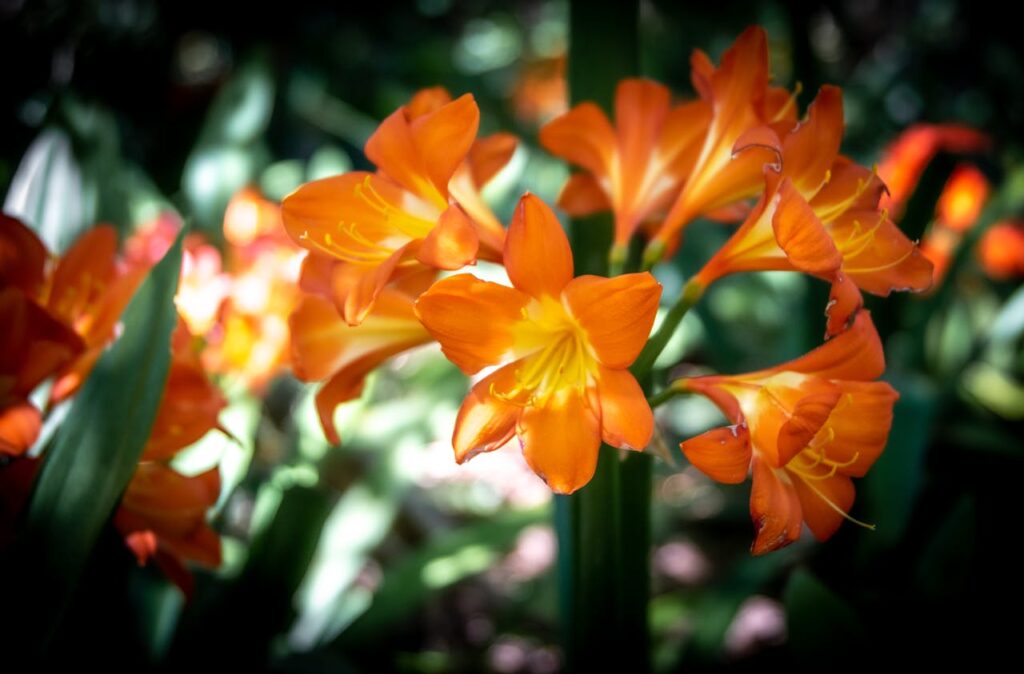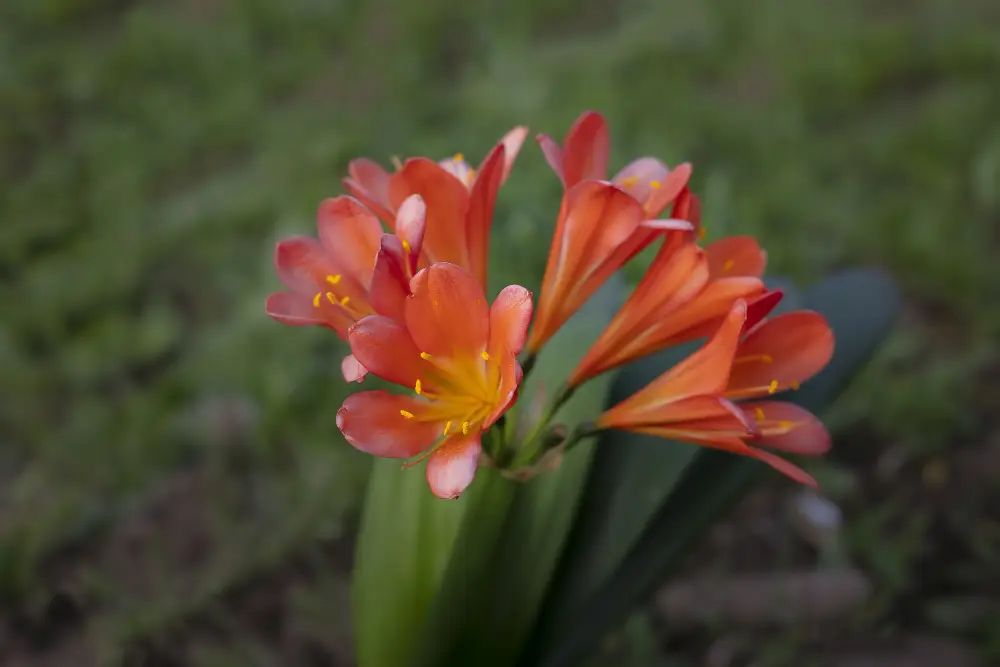Introduction
The Clivia Miniata, commonly referred to as the bush lily, is a gem of a plant renowned for its robust nature and vibrant flowers. This South African native boasts thick, dark-green leaves and mesmerizing orange or red blooms, making it an indoor favorite for many plant enthusiasts. This review will dive deep into the plant’s care requirements, offering insights on how to help it thrive in your home.
Clivia Miniata Indoor Plant Details
| Specification | Detail |
|---|---|
| Common Names | Bush Lily, Kaffir Lily |
| Botanical Name | Clivia Miniata |
| Family | Amaryllidaceae |
| Plant Type | Perennial |
| Mature Size | Up to 18-24 inches tall and 18-24 inches wide |
| Sun Exposure | Bright, indirect light. Can tolerate some morning sun but should be shielded from harsh rays |
| Soil Type | Well-draining potting mix, often enriched with sand or perlite |
| Soil pH | Neutral to slightly acidic (6.0 to 7.5) |
| Bloom Time | Late winter to early spring |
| Flower Color | Most common are orange and red, but varieties can include yellow and pastel tones |
| Hardiness Zones | Typically grown indoors but can thrive outdoors in USDA zones 9-11 |
| Native Area | South Africa, specifically the damp woodlands of the Eastern Cape |
Clivia Miniata is a lush, vibrant indoor plant that is not only aesthetically pleasing but also relatively easy to care for, given its resilience and adaptability. Originating from South Africa, it brings a tropical touch to indoor spaces and can become a focal point in any room with its brilliant blooms. Being aware of its basic specifications ensures it receives the appropriate care to flourish and thrive.
Plant Care
Caring for Clivia Miniata is a delightful experience, especially given its low-maintenance nature. As a plant native to the woodlands of South Africa, it has adapted to varying conditions, making it fairly forgiving to beginner mistakes. With the right balance of light, water, and nutrients, this plant promises to be a standout piece in your indoor garden.
Light Requirements
Clivia Miniata thrives best in bright, indirect light. Although it can tolerate some direct sunlight, especially in the morning, prolonged exposure can lead to leaf scorching. If using artificial lights, fluorescent bulbs placed a few feet away are perfect for creating a conducive environment.
The Right Soil
This plant isn’t particularly fussy about its soil. However, a well-draining potting mix is essential to prevent root rot. Many enthusiasts mix regular potting soil with sand or perlite in a 3:1 ratio to achieve the right consistency.
Watering Tips and Tricks
Watering Clivia Miniata can be described in one word: moderation. Overwatering can lead to root rot. Water the plant thoroughly when the top 1-2 inches of soil feel dry. During winter, reduce the frequency, as the plant goes into a semi-dormant state.
Temperature and Humidity Considerations
Clivia Miniata loves temperatures between 60-75°F (15-24°C). While it can withstand occasional dips, consistent cold can hamper its growth. As for humidity, average household levels are typically adequate. However, during dryer months, a humidifier or misting can help.
Fertilizing Your Clivia Miniata
Feeding your Clivia Miniata isn’t a demanding task. During the growing season (spring and summer), use a balanced liquid fertilizer every 3-4 weeks. In fall and winter, reduce feeding to encourage flowering.
Pruning Insights
While Clivia Miniata doesn’t require frequent pruning, removing dead or yellowing leaves can help improve its appearance. After flowering, cutting back the flower stalks can encourage a more prolific bloom the following season.
Overwintering Your Plant
To help the Clivia Miniata produce vibrant blooms, it requires a period of cooler temperatures (around 50°F or 10°C) during the winter. Limiting water and placing it in a cooler area for 12-14 weeks can prepare it for a vibrant flowering period in spring.
Propagating Clivia Miniata
One of the joys of Clivia Miniata ownership is propagating it. This can be done using offsets (pups) that sprout at the base of a mature plant. Gently separate the pup, ensuring it has roots, and plant it in a separate container.
When Clivia Miniata Starts Declining
A declining Clivia Miniata often signals overwatering or exposure to prolonged direct sunlight. However, with prompt attention to its care requirements, it’s a resilient plant that can bounce back with gusto.
Types of Clivia Miniata Plants
While many know the Clivia Miniata for its classic orange bloom, there are multiple types varying in flower color and leaf form. Here are some popular types:
- Orange/Red Clivia: This is the most common type with deep orange to red flowers.
- Yellow Clivia: A sought-after variety, with a soft yellow bloom.
- Variegated Clivia: Features leaves with unique patterns and often comes with orange or yellow flowers.
- Peach and Pastel Clivia: A rarer type, offering a soft peach or pastel-hued bloom.
Common Pests & Plant Diseases (and Solutions)
Clivia Miniata isn’t overly susceptible to pests and diseases. However, a few issues might arise:
- Mealybugs: These pests look like small cottony masses on the plant. Solution: Wipe off with a cloth dipped in alcohol or use insecticidal soap.
- Spider mites: These are tiny pests that can cause leaves to look speckled. Solution: Increase humidity and clean the plant with a soft cloth. Insecticidal soaps can also be beneficial.
- Root rot: Caused by overwatering. Solution: Ensure proper drainage, and avoid letting the plant sit in water.
- Leaf Spot: Caused by fungi or bacteria. Solution: Remove affected leaves, improve air circulation, and avoid watering on the foliage.
Getting Clivia Miniata to Bloom
Achieving a radiant bloom from your Clivia Miniata requires a bit of patience and care:
- Cool Rest Period: Ensure a colder resting period during winter (around 50°F or 10°C).
- Limit Watering: Reduce watering in winter months.
- Fertilize: Feed your plant with a phosphorus-rich fertilizer leading up to the bloom season.
Common Problems with Clivia Miniata
Clivia Miniata is generally robust, but like all plants, it can have its issues:
- Yellowing Leaves: Often due to overwatering, too much sunlight, or nutrient deficiency.
- Limp Leaves: Typically a sign of under-watering.
- Failure to Bloom: Can be because of a lack of cold resting period or inadequate fertilization.
- Brown Leaf Tips: This can signal low humidity or excessive fertilization.
“Final Thoughts: The Beauty of Clivia Miniata”
Caring for Clivia Miniata offers an unparalleled sense of accomplishment. With its striking leaves and captivating blooms, it’s a testament to the wonders of nature. By adhering to the care guidelines highlighted in this review, you’re bound to enjoy the beauty and vibrance of this plant for years to come.
Frequently Asked Questions
Decode the magic of gardens with our guide to Landscaping Styles Frequently Asked Questions.
Typically once a year, usually in late winter or early spring.
- Yes, it can be toxic if ingested, especially to cats and dogs.
In climates similar to its native habitat (USDA zones 9-11), it can be grown outdoors. However, it’s primarily an indoor plant in most regions.
Overwatering, too much direct sunlight, or nutrient deficiencies can be potential reasons.
Recent Posts
- Modern Mural Ideas Transforming Walls into Artworks
- Thematic Table Decor Dressing Your Table for Special Occasions
- Festive Lighting Ideas Brightening Your Home for the Holidays
- Biodegradable Decor Materials Choosing Earth-Friendly Options
- Personalized Space Decor Making Your Home Uniquely Yours
- New Year’s Eve Decor Ringing in the New Year in Style
- Transforming Junk into Decor Upcycling at Its Best
- Second-Life Decor Objects Giving Old Items New Purpose
- Unique Decoration Crafting Standout Ideas for Your Home
- Environmentally Friendly Styling Decor with a Conscience











